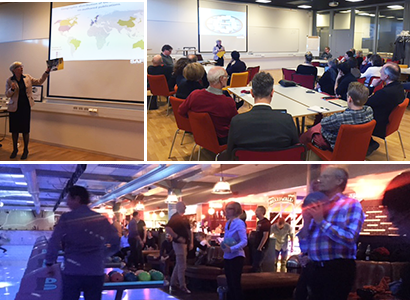SAFER Day report - future trends, SAFER status, and quite a few strikes on the bowling lanes
The 3rd of February we had our first SAFER Day for the year. SAFER Day is intended to gather all people holding a key to SAFER and discuss issues related to the SAFER environment. Anna Nilsson-Ehle, director at SAFER, started with giving an overview of the status of SAFER regarding applications and strategy for future years. SAFER turns ten years on April 1st and Stage 4 starts the same date. The board of SAFER has full focus on finding new funding of SAFER and the chairperson of the board, Karin Svensson, described the work and discussions. Other invited speakers were Michael Balthasar, Volvo Group, Ola Boström, Autoliv, and Tord Hermansson, Volvo Cars.
In the application made 2005 for starting a competence centre in vehicle and traffic safety, it is stated that “in ten years, 150-200 researchers are active, that SAFER would be a world player, with international conferences as an example”. Today we currently have 310 active researchers (at least double the number for all who has passed through SAFER), we are a hub for vehicle and traffic safety research, and have organised several conferences. Around 240 projects have been present at SAFER. The SAFER partners have agreed on a continuation of SAFER and will contribute to financing ”core SAFER”, the basic environment and activities of SAFER.
Inspirational talk
Michael Balthasar, Volvo Group, gave a presentation on future trends and business intelligence. He foresees automatization not only in vehicles but around vehicles. Machine learning opens entirely new approaches and might lead to disruptive innovations. He also made clear that different markets have different maturity and demands and this still means different levels of technologies for products in different countries.
Partners' expectations
Karin Svensson, chairperson of the SAFER board, emphasized that the board and all partners in SAFER strongly support a continuation of SAFER. This is mainly for two reasons: firstly, it takes time to establish a centre from scratch and why create a new one when we have a well-functioning, internationally renowned centre. Secondly, there are still around 1,3 reasons to come to work at SAFER. It is important to save lives, and a collaborative centre like SAFER is needed to eliminate the number of fatalities.
The discussions in the board have concerned the content of the research - the same or modified - and if the setup of the centre needs renewal. The trend is towards automated and connected vehicles and we have to adapt to the new challenges this implies for safety. The meeting place is important as a physical platform for collaboration and interaction. We will surely invite new kinds of partners in the future.
Ola Bostöm, Autoliv and board member in SAFER, described the strength of being interdisciplinary and outside your comfort zone. The interdisciplinary research is a challenge but also the solution. SAFER has to find ways of collaboration with other programmes like Drive Me, Drive Sweden, WASP and VICTA.
Tord Hermansson, Volvo Cars, talked from Volvo Cars’ perspective of being part in SAFER. Volvo Cars is large in Sweden but a small company in a global perspective, and thus it is important to be competent and innovative through collaboration and SAFER plays a leading role in this. SAFER contributes to make Gothenburg interesting and attractive internationally. Volvo Cars supports SAFER, and find it utterly important to attract the best and thus make Gothenburg the centre of gravity for traffic safety.
Group discussion and social event
The group discussions afterwards concerned the international societal perspective and the need of working on a global level. Seek funding from international sources, like SIDA and UN, to really make a difference in decreasing the numbers worldwide. The new UN Global Goals have clear and high ambitions for traffic safety, to cut the number of fatalities with 50% by 2030.
To be on the forefront and live up to the expressed expectations, it is very important for SAFER to be able to fund small pre-studies with own funding. Finally all groups concluded that the communication to SAFER people and partners about what happens at SAFER is very important.
An inter-disciplinary game of bowling ended the day and while some held international excellence standards in strike after strike others tested being outside their comfort zone.
All in true SAFER spirit!

